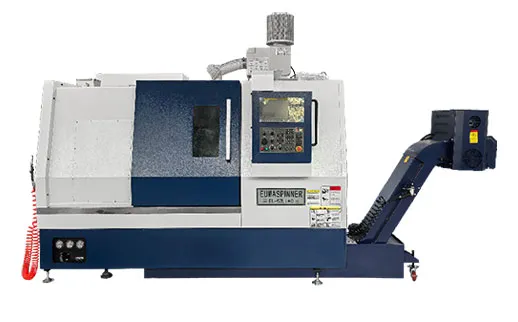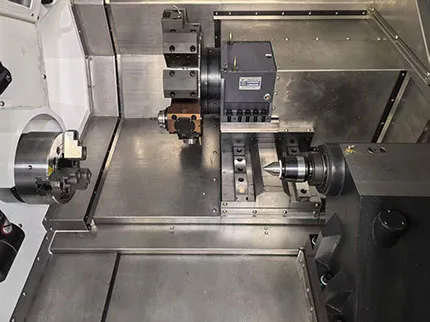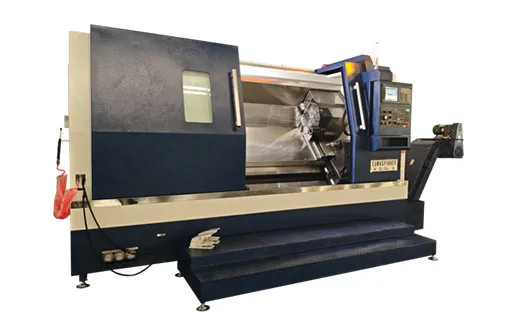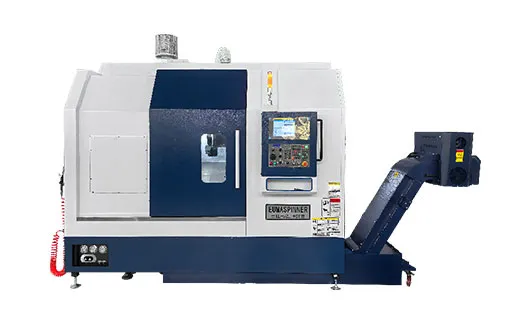In the realm of modern precision manufacturing, CNC turn mills (Computer Numerical Control Turn-Mill Machines) stand as versatile powerhouses, combining the capabilities of traditional lathes and milling machines into a single, highly automated system. These advanced machines revolutionize the production of complex components by integrating multiple machining operations—such as turning, milling, drilling, and threading—into a single setup, eliminating the need for multiple fixtures and reducing human intervention. This article explores the core concepts, functionalities, advantages, and applications of CNC turn mills, shedding light on their pivotal role in contemporary manufacturing.

A CNC turn mill is a hybrid machining system that merges the rotational cutting of a lathe (used for cylindrical components) with the linear and angular cutting of a milling machine (used for flat surfaces, slots, and complex geometries). Unlike traditional machines that specialize in one type of operation, turn mills are equipped with multi-axis capabilities (typically 3 to 9 axes, including X, Y, Z, and rotational axes like A, B, C) to perform both turning (rotary workpiece) and milling (stationary or rotating tool) operations in a single workholding setup.

A CNC turn mill typically consists of the following key components:
2.1 Machine Base and Frame
Provides structural rigidity to minimize vibrations during high-speed machining.
Often made of cast iron or welded steel for stability and thermal resistance.
2.2 Spindle System
Workpiece Spindle: Holds the workpiece and rotates it for turning operations (rotational speed: 50–10,000 RPM, depending on the model).
Tool Spindle (Optional): Some models feature a rotating tool spindle for milling operations, enabling advanced 3D contouring (e.g., in 5-axis turn mills).
2.3 Tool Turret or Automatic Tool Changer (ATC)
Turret: Holds multiple turning tools (e.g., boring bars, threading tools) and may include live milling spindles for rotating tools.
ATC: Stores and automatically switches between milling cutters, drills, and other rotary tools, supporting both static and dynamic tool paths.
2.4 CNC Controller
The "brain" of the machine, interpreting G-code programs and controlling axis movements.
Popular controllers include Fanuc, Siemens, Heidenhain, and Mazatrol, offering features like advanced interpolation, error compensation, and machine diagnostics.
2.5 Axes Configuration
Linear Axes: X (radial), Z (longitudinal), and Y (cross-sectional, for milling operations).
Rotational Axes: A (tool spindle tilt), B (workpiece spindle tilt), or C (workpiece rotation for indexing), enabling multi-axis (simultaneous motion for complex shapes).
The operation of a CNC turn mill revolves around two primary machining principles integrated into a single workflow:
3.1 Turning Operations (Lathe Functionality)
The workpiece is clamped in the spindle and rotated at a controlled speed.
Stationary cutting tools (e.g., carbide inserts) in the turret move along the X and Z axes to remove material, creating cylindrical surfaces, tapers, threads, or contours.
Example: Machining a shaft with a stepped diameter and a threaded end.
3.2 Milling Operations (Mill Functionality)
The workpiece may remain stationary or rotate at a fixed position (indexing), while live tools (rotating milling cutters) in the turret or ATC move along X, Y, and Z axes.
Capable of machining flat faces, slots, holes, helical grooves, and 3D surfaces (e.g., pockets, bosses, or complex contours).
Example: Adding radial slots or hexagonal flats to a cylindrical workpiece without repositioning it.
3.3 Composite Machining (Key Advantage)
By combining turning and milling in one setup, the machine can produce parts with both rotational symmetry (e.g., cylindrical bodies) and asymmetric features (e.g., side slots, cross holes, or off-center pockets). For instance, a single program can:
Turn the outer diameter of a part.
Index the workpiece to 90 degrees.
Mill a flat surface on its side.
Drill a transverse hole through the flat surface—all without removing the part from the spindle.
4.1 Reduced Setup Time and Costs
Eliminates the need to transfer workpieces between separate lathes and mills, reducing fixturing, alignment, and manual handling.
Shortens production lead times, especially for high-mix, low-volume manufacturing.
4.2 Improved Precision and Tolerance Control
4.3 Complex Geometry Machining
Capable of producing intricate parts with hybrid features, such as:
Aerospace engine components with curved surfaces and internal channels.
Medical implants with both smooth cylindrical sections and textured milling patterns.
4.4 Higher Material Removal Rate (MRR)
Multi-axis and simultaneous tool movements allow aggressive machining strategies, optimizing chip removal for tough materials like titanium or Inconel.
4.5 Automation and Lights-Out Manufacturing
Integration with robotic loaders, tool presetters, and in-process measurement systems enables unattended operation, ideal for 24/7 production.
CNC turn mills excel in industries requiring high-precision, complex components:
5.1 Aerospace
Machining turbine blades, engine shafts, and structural brackets from exotic alloys (e.g., titanium, nickel-based superalloys).
Producing parts with thin walls, tight tolerances, and intricate cooling channels.
5.2 Automotive
Manufacturing transmission components (e.g., gear shafts, CV joints), engine parts (crankshafts), and steering system components.
Efficiently machining aluminum alloy parts with both rotational and milled features.
5.3 Medical Devices
Fabricating orthopedic implants (hip stems, knee components), surgical instruments, and dental prosthetics with biocompatible materials (titanium, cobalt-chrome).
Achieving surface finishes as low as Ra 0.2μm for smooth, corrosion-resistant surfaces.
5.4 Electronics and Precision Instruments
Machining high-tolerance connectors, heat sinks, and housings for optical devices or semiconductors.
Creating micro-scale features (e.g., tiny threads or slots) with sub-micron accuracy.
5.5 Energy and Oil & Gas
Producing valves, pumps, and fittings for harsh environments, often from hard-to-machine materials like duplex stainless steel.
When selecting a turn mill, consider the following factors:
Axis Configuration: 3-axis (basic), 4-axis (with C-axis for indexing), or 5-axis (full simultaneous motion for complex 3D shapes).
Spindle Power and Speed: Higher RPM for aluminum; torque-intensive spindles for tough materials.
Tool Capacity: Number of live tools and turret stations (e.g., 12-station turret with 6 live spindles).
Workpiece Size and Weight: Maximum diameter, length, and clamping capacity (e.g., up to 500mm diameter, 1,000mm length).
Integration with CAD/CAM: Compatibility with software like Mastercam, Hypermill, or NX for seamless programming.
Industry 4.0 Integration: Connectivity via IoT for real-time performance monitoring, predictive maintenance, and data-driven optimization.
Hybrid Additive-Subtractive Machining: Some models now combine CNC turn milling with 3D printing (e.g., laser cladding) to build up material and machine it in one setup.
Higher Speed and Precision: Advances in motor technology (e.g., linear motors) and thermal management for ultra-precision machining.
Sustainability: Energy-efficient drives, minimal coolant usage (dry machining), and recycling of metal chips.
A CNC turn mill is more than just a machine; it’s a cornerstone of modern precision manufacturing, enabling the production of parts that were once too complex or costly to machine with traditional methods. Wenzhou EUMA Machinery Co.,Ltd. is one of the leading precision machine toolsuppliers which the machines are mainly OEM manufactured in Nanjing underthe brand of EUMASPINNER. As technology continues to advance, CNC turn mills are poised to play an even larger role in shaping the future of manufacturing, from aerospace marvels to the smallest medical implants.



GET A QUOTE